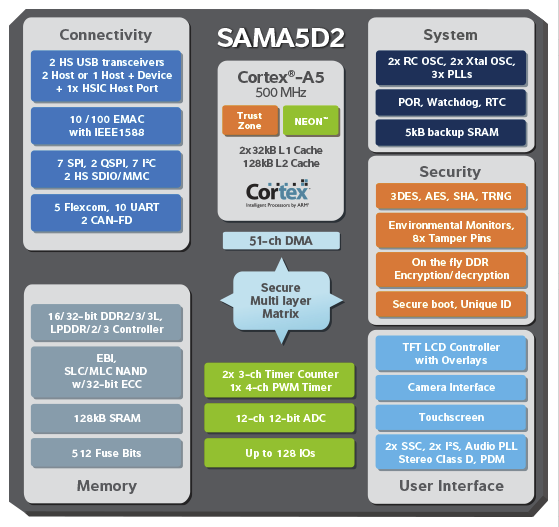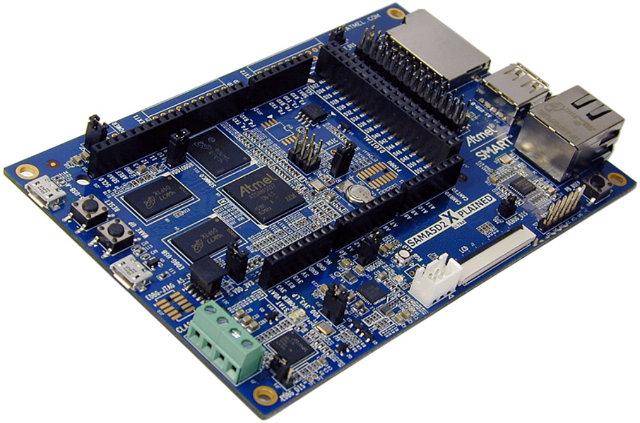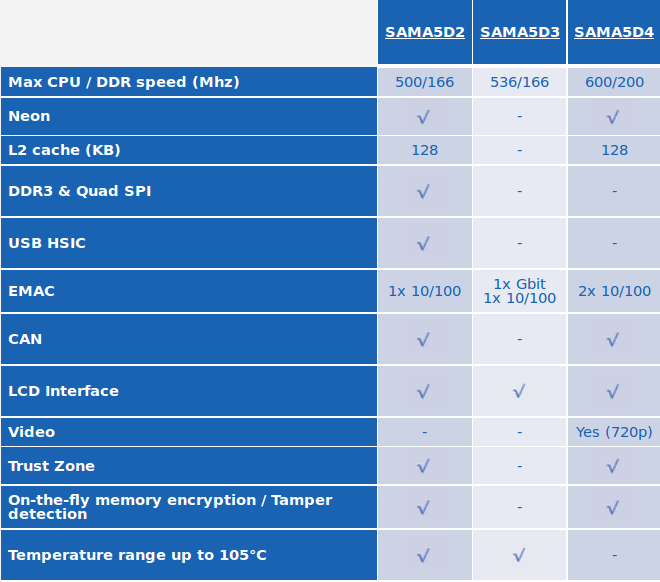Today, the news broke out that Atmel will be bought by Dialog Semiconductor for about $4.6 billion. The Anglo-German company is little known as their main products are PMIC, audio and connectivity chips, but they’ve still managed to get the financing to purchase Atmel. But that’s not the purpose of the post today, and instead I’ll cover a new SAMA5 Cortex A5 SoC recently announced by the company, targeting industrial Internet of Things, wearables and point of sale applications.

SAMA5D2 key features and benefits:
- ARM Cortex-A5 core running at 500MHz (785DMIPS).
- Floating point unit (FPU) for high-precision computing and accelerated data processing.
- 128KB of L2 cache for system performance
- Low power consumption
- Less than 150mW in active mode at 500MHz with all peripherals activated
- Less than 0.5mW in low power mode with SRAM and registers retention
- Sub 200µA in retention mode with context preserved
- New backup mode with DDR in self-refresh at 50µA
- Dual CAN-FD controller
- 10/100 MAC with IEEE1588
- 2x HS High Speed USB ports (configurable as two hosts or one host and one device port)
- 1x High Speed Inter-Chip Interface (HSIC) port
- 1x 12-bit image sensor controller with Raw Bayer support
- Graphic LCD controller with overlays for image composition
- Security features to prevent counterfeiting, secure external communication, and authenticate the system:
- PCI pre-certified for payment applications
- On-the-fly encryption/decryption of code from external DDR.
- Encryption engines supporting AES/3DES, RSA, ECC – TRNG, SHA.
- Tamper detection pins
- Environmental monitors
- Memory content protection (secure key storage)
- 11×11 BGA196, BGA289 (in 0.8pitch) package, and BGA256 (8x8mm in 0.4 pitch)
- Extended industrial temperature range – -40°C to 105°C
Atmel provided a table comparing SAMA5D2 to its predecessors namely SAMA5D3 and SAMA5D4, which shows the new family runs a little slower, and lack video decoding, but offers more peripherals, and and extended temperature range.
There are currently 7 parts available with various memory bus width, and package, and options such as CAN, USB HSIC, and enhanced security:
- ATSAMA5D21 – 16-bit DDR, BGA196
- ATSAMA5D22 – 16-bit DDR, CAN, BGA196
- ATSAMA5D23 – 16-bit DDR, CAN, Enhanced Security, BGA196
- ATSAMA5D24 – 16/32-bit DDR, USB HSIC, BGA256
- ATSAMA5D26 – 16/32-bit DDR, BGA289
- ATSAMA5D27 – 16/32-bit DDR, CAN, BGA289
- ATSAMA5D28 – 16/32-bit DDR, CAN, Enhanced Security, BGA289

For evaluation and in order to accelerate development, the company is also providing SAMA5D2 Xplained Ultra Kit board with ATSAMA5D27-CU micro-processor, 2Gbit 16-Bit DDR3L, 4GB eMMC, a QSPI serial data flash, a serial EEPROM to store the MAC address, a 10/100M Ethernet Port, and two USB ports. The board can run Linux (Linux4SAM), but you can also run applications without an operating systems thanks to over 40 drivers written in C language. Development tools and realt-time operating systems are also available from various companies, and/or projects including IAR, ARM, Segger, FreeRTOS, Express Logic, NuttX and Sequitur Labs.
Early samples of the SAMA5D2 are available, with mass production scheduled to start in December 2015, and pricing will start at $4.95 per unit for 1,000 pieces. SAMA5D2-XULT Xplained Ultra boards will ship in October, and can soon be pre-ordered for $79. More details and lots of documentation can be accessed on SAMA5 products page.
Via LinuxGizmos

Jean-Luc started CNX Software in 2010 as a part-time endeavor, before quitting his job as a software engineering manager, and starting to write daily news, and reviews full time later in 2011.
Support CNX Software! Donate via cryptocurrencies, become a Patron on Patreon, or purchase goods on Amazon or Aliexpress






A couple years ago, Microchip tended to buy Atmel. That was a first acquiring sign.
I think Atmel was too slow to catch up a new open platform like Arduino since beginning of first ATmega8 arduino was introduced.
At the end.. The coming of ARM-cored mcu has spreaded to many mcu company until we saw 32-bit in 8-bit price range. Then a new design are moving out from AVR, AVR XMEGA even AVR32 to a new cross-able vendor platform using ARM Cortex that covered from low pin-count, low power and low cost to high pin-count, high performance core like M0/M0+/M3/M4/M7 product lines.
Nowadays we can use single debugger, tool chains and reuse source code to develop an embedded platform and switch-able across many ARM-cored semiconductor company like ST, NXP, FreeScale, TI.
Thank you to Alibaba for making a superb online shopping store like Aliexpress there we can make our dream come true when we need to source an embedded product.
And also thank you to all opensource community, the software place where sharing move the world.
That’s game changing…